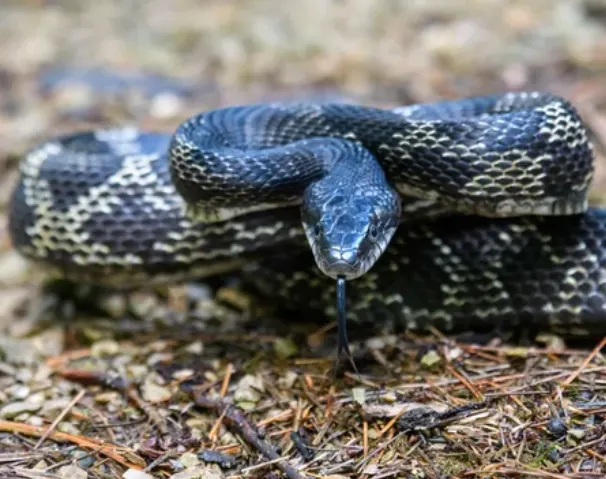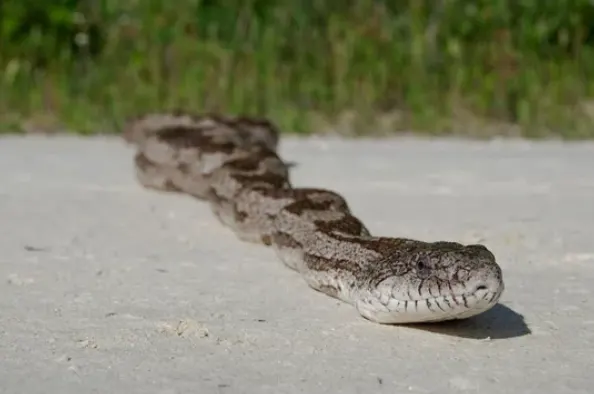Among the most intriguing reptiles in the eastern United States is the Eastern Rat Snake (Pantherophis alleghaniensis). Non-venomous and effective in controlling rodent populations, these snakes play a crucial role in maintaining ecological balance. Despite their intimidating size, they are harmless to humans and highly beneficial to have around.

In this post, we’ll explore everything you need to know about the Eastern Rat Snake—their appearance, habitat, behavior, and why they’re such an important species.
Table of Contents
Quick Facts About the Eastern Rat Snake
- Scientific Name: Pantherophis alleghaniensis
- Common Names: Eastern Rat Snake, Black Rat Snake, Chicken Snake
- Length: 3-6 feet (can grow up to 7 feet)
- Lifespan: 10-15 years
- Diet: Rodents, birds, eggs, small lizards
- Range: Eastern U.S., from Florida to New York
- Conservation Status: Least Concern (though threatened in some states)
Where Can You Find the Eastern Rat Snake?
The Eastern Rat Snake’s habitat spans a wide range, including:
- Forests
- Wetlands
- Farmlands
- Urban and suburban areas
These snakes are especially common in rural areas, where they help keep rodent populations in check. You’ll often find them in barns, attics, or even sheds. They are adaptable and thrive in diverse environments, whether they’re climbing trees in the forest or hiding in a cozy crawlspace.
Appearance: A Master of Camouflage
Color Variations
- Adults: Often have a shiny black body, though some are gray, yellow, or tan, depending on their region.
- Juveniles: Display brown or gray blotches on a tan or gray background, which helps them blend into their environment. As they age, these patterns fade, giving way to their solid adult coloration.
Key Features
- Checkerboard Belly: A striking pattern of black and white on their stomach.
- Cream Markings: Typically seen under their chin and throat.
- Wedge-shaped Head: Larger than their body, their head gives them a distinctive, somewhat intimidating look.
Size
- Males are typically larger than females, with lengths ranging from 3-6 feet on average, though some individuals can grow up to 7 feet long.
Behavior: The Silent Rodent Hunter
How They Hunt
Eastern Rat Snakes are ambush predators. They hide and wait for their prey, which primarily consists of:
- Rodents (their favorite!)
- Birds
- Eggs
- Small lizards
Once they capture their prey, they constrict it, using their powerful coils to suffocate the animal. This method is highly effective, allowing them to control rodent populations, especially in agricultural areas.
Self-Defense Techniques
Despite their large size, Eastern Rat Snakes are generally docile and shy. When threatened, they resort to several clever tactics:
- Puffing up their bodies to appear larger
- Releasing a foul-smelling musk to ward off predators
- Mimicking venomous snakes by flattening their heads and vibrating their tails (imitating a rattlesnake)
Surviving the Winter: Brumation
Like many reptiles, Eastern Rat Snakes are cold-blooded and rely on external heat to stay warm. During the colder months, they enter brumation, a reptilian form of hibernation where their metabolism slows down dramatically.
Where Do They Brumate?
- Underground burrows
- Crevices in rocks
- Basements or crawlspaces
Before winter arrives, these snakes build up fat reserves to sustain themselves through the season. Their adaptability helps them survive in both rural and urban environments.
Myths and Misconceptions
Are Eastern Rat Snakes Dangerous?
No! Eastern Rat Snakes are non-venomous and pose no threat to humans. They rarely bite unless cornered or handled aggressively, and even then, their bite is harmless.
Myth 1: Hybrid with Copperheads
One common myth is that Eastern Rat Snakes can hybridize with copperheads, creating a dangerous cross-species snake. This is biologically impossible.
Myth 2: Pilot Snakes
Another misconception is that they act as “pilots” for venomous snakes, guiding them to safety. This myth likely stems from the fact that Eastern Rat Snakes and venomous species share similar habitats, but it’s entirely untrue.
Why You Should Welcome Eastern Rat Snakes in Your Yard
Eastern Rat Snakes are beneficial creatures to have around your home and garden. Here’s why:
Natural Pest Control
They help control populations of rodents and other small pests, reducing the need for chemical pest control methods.
Non-Aggressive Nature
Unlike venomous snakes, Eastern Rat Snakes are docile and prefer to flee rather than fight. They are not a threat to humans or pets.
Eastern Rat Snakes as Pets
If you’re thinking of keeping a snake as a pet, the Eastern Rat Snake is a fantastic option for first-time owners. Here’s why:
- Easy to Care For: They thrive on a diet of rodents and are relatively low-maintenance.
- Docile Personality: Their calm demeanor makes them easy to handle.
- Long Lifespan: With a lifespan of 10-15 years, they’re a long-term commitment.
Many people find them fascinating companions, though they won’t be as affectionate as traditional pets like cats or dogs.

Conservation Status: Stable but Threatened in Some Areas
While the Eastern Rat Snake is listed as “Least Concern” on the IUCN Red List, they are considered threatened in Vermont and endangered in Maine due to habitat loss and human activity.
What Can Be Done?
- Habitat Protection: Preserving natural areas and educating people about the ecological importance of these snakes can help ensure their survival.
- Safe Road Crossings: Reducing road mortality through the use of wildlife crossings and tunnels can help protect their populations.
The Gentle Guardian of Your Yard
The Eastern Rat Snake is a fascinating, harmless, and beneficial species that plays a crucial role in controlling rodent populations and maintaining the balance of the ecosystem. With their adaptability, non-aggressive nature, and pest control abilities, they are much more friend than foe.
The next time you spot an Eastern Rat Snake slithering around your yard or in a nearby tree, take a moment to appreciate the work they’re doing behind the scenes to keep nature—and your garden—healthy.
- Enchi Ball Python: A Unique and Stunning Morph of Python regius - March 27, 2025
- Emerald Tree Monitor: The Enigmatic Green Guardian of the Rainforest - March 26, 2025
- The Egyptian Cobra (Naja haje): A Fascinating Serpent - March 25, 2025
